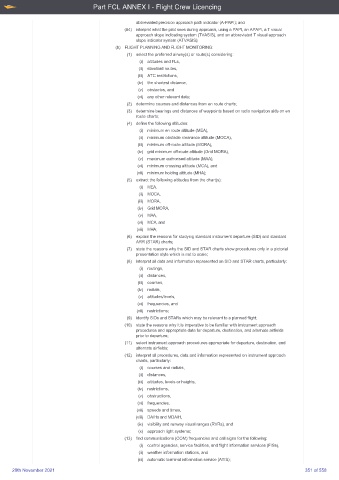Page 351 - UK Aircrew Regulations (Consolidated) 201121
P. 351
Part FCL ANNEX I - Flight Crew Licencing
abbreviated precision approach path indicator (A-PAPI); and
(84) interpret what the pilot sees during approach, using a PAPI, an APAPI, a T visual
approach slope indicating system (TVASIS), and an abbreviated T visual approach
slope indicator system (ATVASIS);
(b) FLIGHT PLANNING AND FLIGHT MONITORING:
(1) select the preferred airway(s) or route(s) considering:
(i) altitudes and FLs,
(ii) standard routes,
(iii) ATC restrictions,
(iv) the shortest distance,
(v) obstacles, and
(vi) any other relevant data;
(2) determine courses and distances from en route charts;
(3) determine bearings and distances of waypoints based on radio navigation aids on en
route charts;
(4) define the following altitudes:
(i) minimum en route altitude (MEA),
(ii) minimum obstacle clearance altitude (MOCA),
(iii) minimum off-route altitude (MORA),
(iv) grid minimum off-route altitude (Grid MORA),
(v) maximum authorised altitude (MAA),
(vi) minimum crossing altitude (MCA), and
(vii) minimum holding altitude (MHA);
(5) extract the following altitudes from the chart(s):
(i) MEA,
(ii) MOCA,
(iii) MORA,
(iv) Grid MORA,
(v) M A A ,
(vi) MCA, and
(vii) M H A ;
(6) explain the reasons for studying standard instrument departure (SID) and standard
ARR (STAR) charts;
(7) state the reasons why the SID and STAR charts show procedures only in a pictorial
presentation style which is not to scale;
(8) interpret all data and information represented on SID and STAR charts, particularly:
(i) routings,
(ii) distances,
(iii) courses,
(iv) radials,
(v) altitudes/levels,
(vi) frequencies, and
(vii) restrictions;
(9) identify SIDs and STARs which may be relevant to a planned flight;
(10) state the reasons why it is imperative to be familiar with instrument approach
procedures and appropriate data for departure, destination, and alternate airfields
prior to departure;
(11) select instrument approach procedures appropriate for departure, destination, and
alternate airfields;
(12) interpret all procedures, data and information represented on instrument approach
charts, particularly:
(i) courses and radials,
(ii) distances,
(iii) altitudes, levels or heights,
(iv) restrictions,
(v) obstructions,
(vi) frequencies,
(vii) speeds and times,
(viii) DA/Hs and MDA/H,
(ix) visibility and runway visual ranges (RVRs), and
(x) approach light systems;
(13) find communications (COM) frequencies and call signs for the following:
(i) control agencies, service facilities, and flight information services (FISs),
(ii) weather information stations, and
(iii) automatic terminal information service (ATIS);
20th November 2021 351 of 558

